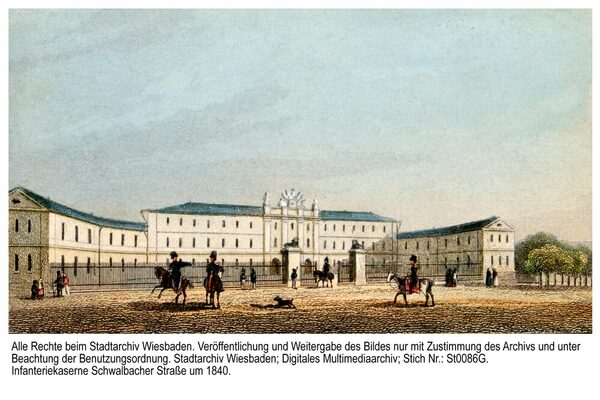Barracks
The oldest barracks from the Nassau military era was the Old Infantry Barracks built by Carl Florian Goetz in 1816-19 on the west side of Schwalbacher Straße. The building consisted of a wide three-storey, three-winged complex with a representative central risalit and formed an imposing end to Friedrichstraße. Over the following years, the complex was constantly extended until it was demolished in 1911/12. The two life-size lions carved from sandstone, which were enthroned on the two gate pillars, are now located on the Neroberg. In 1828/29, new barracks were also built for the Nassau artillery, which had previously been housed in the outbuildings of the palace, in the area that later became Rheinstraße, Luisenstraße, Kirchgasse and Schwalbacher Straße. The center of this artillery barracks was a simple neoclassical building, which was also abandoned as a barracks at the beginning of the 20th century and destroyed during the bombing raid on 02.02.1945. The new infantry and field artillery barracks were built in today's Europaviertel. The regiment von Gersdorff was the first to move into the new barracks in April 1897. Further construction phases followed in 1907-09 and 1909-12.
After the First World War, there was no longer a German garrison in Wiesbaden and the barracks were first occupied by the French (Foch Barracks and Pétain Barracks), later by the British (Saint-Andrew Barracks and Ypres Barracks) and then again by the French. After the withdrawal of the Allied occupation, the site was used for civilian purposes until German troops returned to Wiesbaden in 1936 as part of the remilitarization of the Rhineland. Until the outbreak of the Second World War, the existing barracks facilities were continuously consolidated and extended to the east. The three sections were named Ochamps-Kaserne, Oranien-Kaserne and Gersdorff-Kaserne. In addition to the new Kohlheck Barracks and the Freudenberg Barracks in Dotzheim, which were also built by the National Socialists, the Wiesbaden garrison also included further military hospital buildings and, from 1937, the new air base in Erbenheim. After the Second World War, the facility on Schiersteiner Straße was used from 1945-47 as a United Nations collection camp for refugees, displaced persons and former forced laborers and was later taken over by the Americans; it was given the name Lindsey Air Station. Since the withdrawal of the American forces in the 1990s, the site has been home to the Europaviertel. The Freudenberg barracks were also used by American troops (Camp Pieri), released in 1993 and converted into a residential area.
Biebrich also has a long tradition as a garrison town; the brick building of the Rhine barracks in Rheingaustraße, built in 1857-60, has been preserved to this day. It was initially occupied by a ducal Jäger battalion, and until the First World War the "Royal Prussian NCO School" was stationed there, which was moved to Wetzlar in 1914. Pioneer Battalion 52 moved into the Rhine barracks. In addition, the Hindenburg barracks were built in 1914-16 on today's Äppelallee to provide space for a new "NCO preliminary school". After 1918, Allied soldiers also moved into the barracks here. In the course of German rearmament, a German garrison also came to Biebrich, which was replaced by American soldiers after the Second World War. They left the Biebrich barracks in the 1970s. The former Rhine barracks are now home to the Hessian State Office for the Environment and Geology, while the former Hindenburg barracks have been integrated into the Federal Criminal Police Office complex.
The former Reduit (barracks) in Kastel served as part of the Mainz federal fortress for bridge protection on the right bank of the Rhine, which is why it was also known as the bridgehead barracks. Kastel was also home to the Von-der-Goltz barracks and the Wilhems barracks built in 1860, which were occupied by pioneer troops most of the time. The latter was demolished in the 1930s. The Mudra barracks in Kastel were built in 1908/1909 as accommodation for the 2nd Nassau Pioneer Battalion No. 25, taken over by the French occupying forces after 1918 and renamed "Quartier Marceau". In 1936, the Wehrmacht's Pioneer Battalion 36 moved in here; the complex was given its current name after the pioneer general Bruno von Mudra. The Hessian riot police have been using the building since 1951.
As one of the last barracks in Wiesbaden, the Schiersteiner Hafenkaserne was vacated by the soldiers of the Bundeswehr in 1994. After the Second World War, American troops were initially stationed here until the facility was handed over to the Bundeswehr in 1958. After the last pioneer units were disbanded, the barracks site was transferred to civilian use.
Literature
From parade ground to residential quarter. The history of the Europaviertel. Edited by the Rheingauviertel/Hollerborn Local Advisory Council in conjunction with the Wiesbaden Urban Development Corporation and Cultural Office/City Archive, Wiesbaden 2010.
Sigrid Russ, editor, Denkmaltopographie Bundesrepublik Deutschland. Cultural monuments in Hesse. Wiesbaden I.1 - Historical pentagon. Edited by: State Office for Monument Preservation Hesse, Stuttgart 2005.
Sigrid Russ, editor, Denkmaltopographie Bundesrepublik Deutschland. Cultural monuments in Hesse. Wiesbaden I.2 - City extensions within the ring road. Ed.: State Office for Monument Preservation Hesse, Stuttgart 2005.
Sigrid Russ, editor, Denkmaltopographie Bundesrepublik Deutschland. Cultural monuments in Hesse. Wiesbaden I.3 - Urban extensions outside the ring road. Ed.: State Office for Monument Preservation Hesse, Stuttgart 2005.
